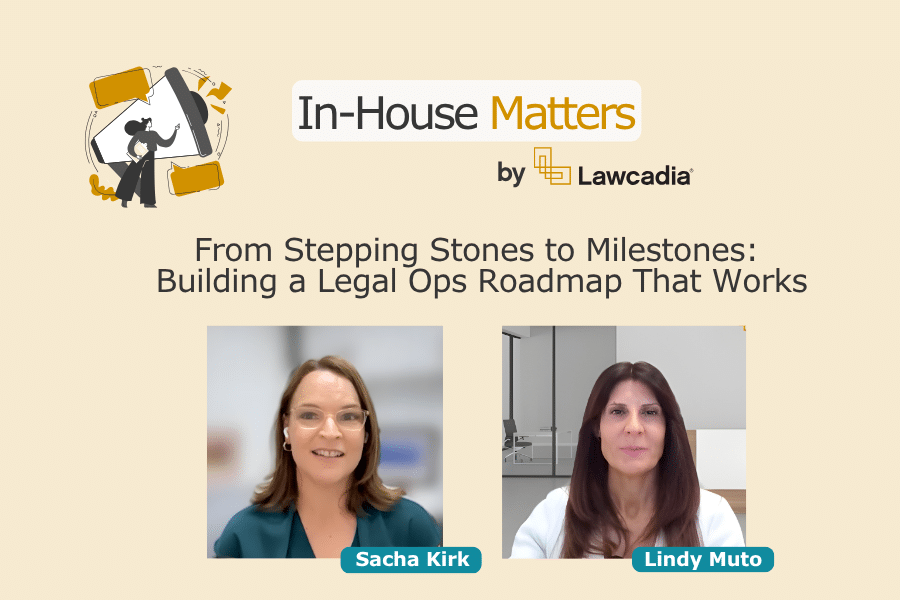In the latest In-House Matters webinar, Lawcadia’s Co-Founder and Chief Marketing Officer, Sacha Kirk, spoke with Lindy Muto, Legal Operations Manager at ASIC, about how to identify priorities, build momentum, and deliver measurable impact in legal operations.
Drawing on her experience as both a General Counsel and a highly experienced legal operations professional, Lindy shared practical insights, candid reflections, and actionable advice for legal teams at any stage of their transformation journey.
1. Start with insight
“Every team’s starting point is going to be different depending on the maturity of their team and where they are in their legal ops journey. But generally, I always tell people to start by understanding what the current pain points, problems, and inefficiencies are within their teams.”
Lindy explained the importance of interviewing stakeholders to uncover challenges and gather data-driven evidence. “I have interviewed everyone in a firm up to 80 people from a receptionist to a managing partner to a group of 20 to 30 people who represent not only the legal team but the business unit within the organisation.”
“It’s also really important to look at existing data that you’ve got within the team because that data will help you identify additional bottlenecks, whether that be from billing to contract lifecycle management to external legal spend.”
Once those insights are gathered, she aligns them with the broader business objectives: “So that alignment is going to give you a greater return, not just for value for the legal team, but for the whole organisation.”
2. Plan the journey
A legal operations roadmap, Lindy said, is both a strategy and a communication tool. “It’s a high-level plan that identifies all of your initiatives, your quick wins, your major projects, and what’s the timeline to achieve each one of those.”
She cautioned that it should never be static. “I think it’s important to note that the roadmap, although it’s this high-level plan, it is not a ‘set and forget’ document. It is a live document that you constantly need to change based on the priorities and the changes within your team and your organisation or law firm.”
Keeping the roadmap current helps the team stay focused and accountable. “Otherwise, sometimes in legal operations you could be pulled from pillar to post because so many people have different ideas. And you need to be really purposeful and make sure that you are there fixing the little issues that are actually going to have an impact on the bigger picture.”
3. Show visible progress
Demonstrating quick, visible success is key to building credibility. “You’ve probably heard this a thousand times, but you really need to take the people on the journey. You need to show them that the change is actually not scary. It’s not a burden to their day-to-day lives.”
She shared a tangible example of mapping a complex document-signing process and integrating an e-signing tool: “We mapped out what the current process was, and then mapped out the future state, and that was about integrating the new e-signing tool into their document management system where we actually eliminated the time spent uploading and downloading documents, reducing that email correspondence regarding whether or not a document was executed, tracking where that document was in the signing process.”
“It improved their interaction with clients and as soon as they saw something so simple adding so much value to their life, all they wanted is more.”
4. Lead engagement
To gain buy-in from senior leaders and the wider business, Lindy recommended tailoring communication and recognising that not everyone will respond in the same way. “I found some strategies that I’ve used with some senior leaders is mapping their personas and understanding where they’re coming from and maybe it’s the way that they learn is different.”
“Once I’ve been able to identify the way they learn, I might spend one-on-one time with them [or] I might do group sessions because that’s the way they prefer to ingest information.”
“We also need to encourage the senior leaders to lead by example.”
She cautioned that resistance at the top can derail progress: “As soon as [a senior leader] didn’t take those on, then everyone else would say if he doesn’t do it, I won’t do it.”
5. Bridge the business
Legal operations professionals, particularly those without a legal background, need to invest time in understanding the legal environment. “I really think they need to understand the landscape of law firms. They need to understand how the lawyers operate and I think they need to spend time with the lawyers and the different practice areas within the law firm or the in-house team to fully embrace the way that they actually work and what their pain points are.”
There can also be important opportunities for legal operations to bridge the gap between the legal function and other parts of the organisation. For example when working with IT, “There’s a communication barrier there and they need someone who’s able to translate that language between the IT language and the legal language.
7. Commit to the long game
Reflecting on her own career, Lindy spoke candidly about transitioning from a lawyer to a legal operations professional. “As a lawyer, it was a very stable career, and I worked and lived all over the world and progression was quite easy and identifiable because I was a revenue earner. Then I became a cost centre, and I returned to Australia, and the market wasn’t as mature as it is in other markets.”
She offered advice to those considering a similar move: “What I learned when looking for legal operations roles, especially here in Australia, is to make sure that legal operations is actually within [the organisation’s] long-term vision and direction. It’s not just the shiny new thing that they want to be be part of.”
“You want to make sure that the organisation has had a really considered approach, [and that] legal operations is being built as part of their strategy, and the organisation has a mindset of improvement and efficiency for a long-term gain, not just one-off projects.”
Lindy also reinforces the importance for legal operations professionals to “keep selling legal operations as being that Chief Operating Officer for legal teams.”
Lessons for In-House Leaders
For General Counsel and legal operations leaders in corporate and government environments, Lindy’s experience offers practical takeaways for driving operational excellence and embedding sustainable change:
- Start with evidence, not assumptions: Use interviews and data to uncover real pain points before investing in technology or change initiatives.
- Align with organisational strategy: Projects that clearly support business objectives are more likely to gain funding and executive buy-in.
- Show quick wins: Early, visible successes build confidence and create the momentum needed for larger transformation.
- Model the change you want to see: Leadership engagement is crucial — when senior lawyers adopt new processes, others follow.
- Think long-term: Sustainable legal operations requires ongoing commitment, strategic alignment, and a culture of continuous improvement.
Watch the full conversation with Lindy Muto in the latest episode of In-House Matters by Lawcadia.

